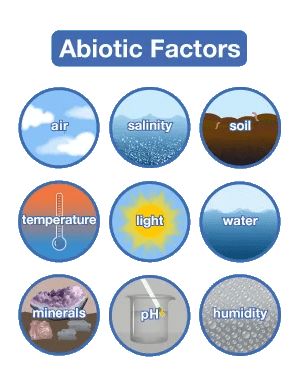Introduction
The ecosystem is defined as a geographical area composed of living beings and non-living beings interacting with each other. Both of them are interdependent and hence together are responsible for maintaining the balance of the environment. Living beings in an ecosystem are termed biotic factors; they include microbes, plants, and animals. Non-living beings of an ecosystem are known as abiotic factors and they are physical or chemical non-living components of the ecosystem. These factors are essential for the survival of living organisms in the given ecosystem. They determine the structure, growth pattern, distribution, and behaviour of the living organism in an ecosystem. These factors include temperature, light, humidity, water, air, land, soil, pH, etc.
Types of Abiotic Factors
There are 3 types of abiotic factors-
- Inorganic compounds-Compounds and elements which are a part of various biogeochemical cycles are the inorganic compounds found in the ecosystem and they are very essential for the biotic components. Nitrogen, phosphorus, carbon, and other elements are examples of inorganic materials.
- Organic compounds- These are the substances that are present in dead and decaying organisms. These include biomolecules like lipids, proteins, and carbohydrates. These organic components are broken down into simpler compounds such as carbon, hydrogen, oxygen, and nitrogen which circulate in the ecosystem and nourish various abiotic factors such as soil, air, water, etc.
- Climatic and soil factors-These variables include the ecosystem’s physical elements, such as temperature, humidity, light, air, and soil. Climate variables are those that affect the weather or climatic condition of the ecosystem, whereas edaphic factors are those that affect the qualities of the soil, such as pH and topography.
For more help, you can Refer to Lesson 9 – Living Things and habitat in Science Class 6th. Checkout the video Lesson for a better understanding

Ecosystems Based on Abiotic Factors
Abiotic elements found in a given habitat can be used to categorize ecosystems.
- Aquatic ecosystem- An ecosystem is said to be aquatic if both its biotic and abiotic components are found in water. Depending upon the salinity of the water, aquatic ecosystems can be of two types- Freshwater ecosystems and Marine ecosystems.
- Terrestrial ecosystem- An ecosystem is referred to as a terrestrial ecosystem if the biotic and abiotic components reside on the land. Depending upon various factors such as availability of water, climatic conditions, and temperature. Terrestrial ecosystems can be of 4 types- Forest, Grassland, Mountain, and Desert ecosystem.
Responses of Organisms Against Changes in Abiotic Factors
Biotic factors that inhabit a certain habitat react with the abiotic elements present there. Hence, the abiotic factors become stimuli which results in the display of various effects on different organisms. Below are a few examples
- Homeostasis-Homeostasis is the process by which the interior environment of organisms is maintained in a steady state, despite various external changes. Organisms can be divided into two categories:
- Regulators-These species can use energy to maintain homeostasis. They are active, widely dispersed, and maintain a steady internal body temperature and osmotic concentration. For e.g.- Birds and mammals.
- Conformers- These species are unable to maintain homeostasis and hence can survive only in specific conditions. For eg- Fish, amphibians, reptiles, etc.
- Migration– Migration is the movement of living creators from one place to another. Such creatures temporarily migrate to a suitable location when there are unfavourable conditions in their native habitat. They return to their former habitat as soon as the environment is normalized. For example- To avoid the severe winter climate, birds from Siberia travel to India.
- Suspension- When faced with unfavourable circumstances, certain species briefly halt their continuous metabolism i.e they suspend their growth and development for a while. For eg- Spores are formed by fungi and bacteria which can withstand severe conditions. Plants produce seeds that have a thick seed coat and a period of dormancy. While snails and frogs become dormant in the summer, bears hibernate during the colder months.
Summary
Abiotic elements are the nonliving parts of an ecosystem that surround living ones in any habitat. Both aquatic and terrestrial habitats include them. The biotic components are occasionally impacted by changing abiotic variables. To ensure their existence, these biotic components have a variety of strategies to deal with changes in these abiotic conditions.
Frequently Asked Questions
1. What is a Local and Global Ecosystem?
Ans: A local ecosystem consists of different types of habitats along with living organisms. A global ecosystem is a group of many local ecosystems.
2. What is Diapause?
Ans: Diapause is a response given by organisms under unsuitable environmental conditions. It is a spontaneous phenomenon wherein there is an interruption in the developmental stage of an organism due to changes in the abiotic factors. For instance, the monarch butterfly goes through reproductive diapause to get ready for its migration from North America to Mexico between late summer and fall.
3. What are the Abiotic Factors in a Forest Habitat?
Ans: The abiotic factors of forest habitat are-
- Soil
- Temperature
- Humidity
- Rocks
- Water
4. Give one Example of a Plant’s Response to Abiotic Factors of the Environment.
Ans: One example of a plant’s reaction to the abiotic component of light is phototropism. In contrast to the root, which grows away from the light source and exhibits negative phototropism, the plant’s shoot grows in the direction of the source of light and shows positive phototropism.